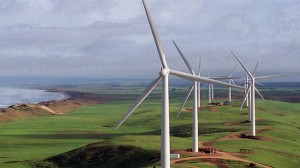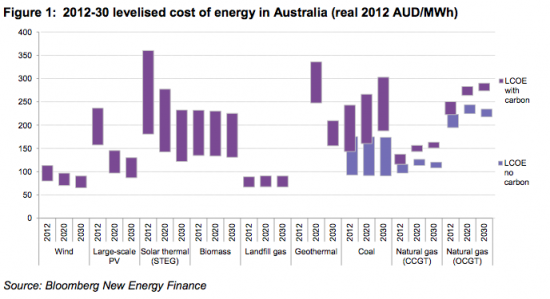In Australia, Wind Power Is Already Cheaper Than Fossil Fuels, And Solar Is Right Behind
 According to the latest research from Bloomberg New Energy Finance, electricity from wind power can now be supplied more cheaply in Australia than power from either coal or natural gas — and solar and other forms of renewable energy aren’t far behind.
According to the latest research from Bloomberg New Energy Finance, electricity from wind power can now be supplied more cheaply in Australia than power from either coal or natural gas — and solar and other forms of renewable energy aren’t far behind.Older coal-fired power plants from the 70s and 80s still compete at lower prices than renewables — but only because their construction costs have depreciated. For the deployment of any new power generation in Australia, renewables now appear to be the way to go.
Australia currently charges polluters $23 in Australian dollars per metric ton of carbon they emit, but the study concluded that wind power would still undercut fossil fuels even without that correction of the market’s failure to properly build in the costs of carbon pollution:
The study shows that electricity can be supplied from a new wind farm at a cost of [$80 per megawatt hour in Australian dollars], compared to [$143 per megawatt hour] from a new coal plant or [$116 per megawatt hour] from a new baseload gas plant, including the cost of emissions under the Gillard government’s carbon pricing scheme. However even without a carbon price (the most efficient way to reduce economy-wide emissions) wind energy is 14% cheaper than new coal and 18% cheaper than new gas….
Bloomberg New Energy Finance’s research on Australia shows that since 2011, the cost of wind generation has fallen by 10% and the cost of solar photovoltaics by 29%. In contrast, the cost of energy from new fossil-fuelled plants is high and rising. New coal is made expensive by high financing costs. The study surveyed Australia’s four largest banks and found that lenders are unlikely to finance new coal without a substantial risk premium due to the reputational damage of emissions-intensive investments – if they are to finance coal at all.
Here’s a graphic of BNEF’s findings, courtesy of Renew Economy:

So the study expects both coal and natural gas to rise in cost over the next two decades. Among other things, coal power consumes more water than any other source of energy. That will drive up coal’s cost, as fresh water becomes scarcer due to the very climate change driven by coal power’s carbon emissions. And in America, at least, there’s evidence that the major proven natural gas reserves will peak out within the time frame of BNEF’s analysis, rendering the boom in that energy source decidedly temporary.
Meanwhile, while the costs of solar and other forms of renewables are currently lagging, they’re dropping fast:
BNEF’s analysts conclude that by 2020, large-scale solar PV will also be cheaper than coal and gas, when carbon prices are factored in. By 2030, dispatchable renewable generating technologies such as biomass and solar thermal could also be cost-competitive.
According to companies like Ratch Australia, the cost of deploying new solar photovoltaics is already down to between $120 and $150 per megawatt hour, suggesting it may be dropping even faster than BNEF concluded. Kobad Bhavnagri, head of BNEF’s clean energy research in Australia, expects that by 2020 or 2030 “we will be finding new and innovative ways to deal with the intermittency of wind and solar.” And since Australia is most likely set for baseload capacity until at least 2020, when solar as well as wind will be undercutting fossil fuels, “it is quite conceivable that we could leapfrog straight from coal to renewables to reduce emissions as carbon prices rise.”
The world’s biggest manufacturer of wind turbines already has 50 percent of Australia’s market, which it expects to hold. And China’s largest manufacturer is eyeing the market as well. The deployment of rooftop solar is already dramatically reshaping the energy market in southern Australia, and the Green Party in Western Australia recently proposed installing solar panels on all public housing homes.
And while a move towards renewable energy by Australia’s economy certainly won’t fix global warming on its own, it’s a step in the right direction, away from the rash of heat waves and wildfires — worsened by the climate change driven by fossil fuels’ carbon emissions — that have recently slammed the nation.
You can return to the main Market News page, or press the Back button on your browser.

